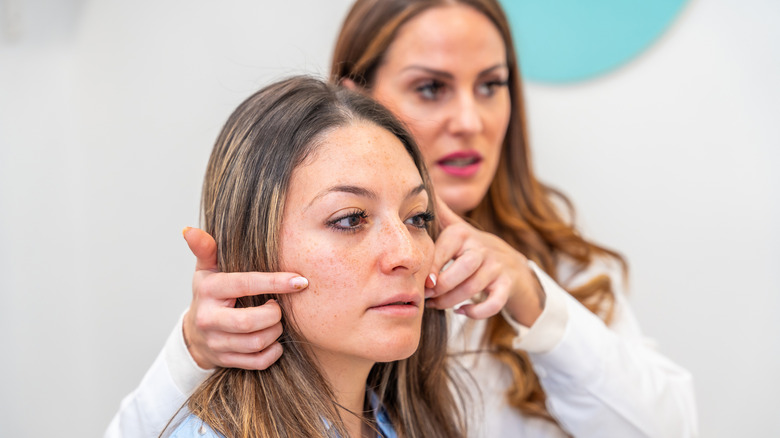Tips To Make Sure Your Filler Stays Undetectable
Our cultural relationship with getting work done has changed. Per one survey by Spa Medica, in 2023, Botox treatments saw a 26% increase in popularity compared to 2022, with millions of people opting for the procedure. However, with the rise in minimalist skincare and the clean girl aesthetic, there's been a shift in the kind of results people want from the treatment. People aren't willing to exchange wrinkles for an expressionless face anymore. That payoff is simply too high, and so anti-aging treatments are adapting to meet this new demand.
Although there's no shame in getting work done, the growing expectation is for it to be largely undetectable. People want to take action to mitigate signs of aging without drastically changing the way they look, which is just another way of saying that the work they've had done isn't obvious. In essence, this means that the provider applies less product, more strategically placed. People are doing more research into different types of filler, namely kinds that can or cannot be dissolved. The growing movement wants greater options without feeling trapped into making drastic decisions.
Of course, many of us have all encountered someone — whether in person or on screen — who went a bit overboard with the injections to the point of it being obvious. Whether it's overly puffy cheeks or frozen eyebrows, there are numerous tells that a person has had work done. Given that these treatments cost upwards the triple digits, the last thing anyone wants is to look like they've had work done. To ensure you don't encounter similar issues, it's important to go into your treatment knowing exactly what you want. Women.com spoke with Dr. Dennis Schimpf, a Board Certified Charleston, South Carolina Plastic Surgeon who gave us several tips to keep your filler from looking obvious.
Start with fewer units
Dr. Dennis Schimpf stressed that one common reason why some people end up with a frozen face after filler is because they've received too much in one particular spot. "When too much filler is used, it can lead to unnatural puffiness, overly rounded features, or distortions in facial proportions," he explained, noting that the providers are trying to overcorrect signs of aging. He also said that excessive Botox in particular can lead to excessive muscle restriction, since Botox blocks nerve signals, thus inhibiting movement.
The secret, then, as Dr. Schimpf explained, is to start with fewer units than what is typically used in a full treatment. For example, a typical procedure for crow's feet applies 6 to 12 units per side of the face. A smaller treatment would be 5 to 10 units. Dr. Schimpf also suggested getting "Baby Botox" or microdosing the treatment. "This approach uses even smaller amounts, often 10–20 units total spread across multiple areas, to achieve a subtle, natural look while maintaining some movement," he told Women.com.
Starting with smaller doses is especially important for new patients. Dr. Schimpf explained that this allows the practitioner to see how the filler settles on their face. "For someone new to Botox, a smaller dose ensures a conservative approach, avoiding over-treatment and giving the practitioner a baseline to work with in future sessions," he explained. It also gives a person time to see the effects of treatments.
Focus on facial symmetry
Instead of focusing on getting rid of wrinkles, a better approach to take when getting injections is to think about facial symmetry. Dr. Dennis Schimpf explained that this approach focuses on a person's unique anatomy, aging patterns, and aesthetic goals. For example, if a patient is concerned about marionette lines (the vertical lines that go from the mouth to the chin), a practitioner will likely reach for Hyaluronic acid fillers like Juvederm or Restylane. But all the work is done with facial symmetry as the priority. "To maintain symmetry, the surgeon ensures equal amounts of filler are placed on both sides, taking into account any existing asymmetry," Dr. Schimpf told us. "They may also use filler to subtly enhance the jawline or chin if volume loss there contributes to the imbalance."
For something like horizontal forehead wrinkles, a skilled practitioner will avoid over-treating one side. "If the patient has a naturally higher arch on one eyebrow, the surgeon might adjust injection points to subtly even out the brows," Dr. Schimpf added, noting how the work should modify for each unique face. The ultimate goal, no matter what the targeted area is on the face, is to maintain overall symmetry. "The surgeon may assess other areas of the face to ensure harmony," Dr. Schimpf noted. If some volume is needed in the midface after these other areas have been treated, a practitioner may add some to create a connected look.
Communicate your goals with your practitioner
To avoid overdoing it with filler, it's also important to speak with your practitioner about what you're hoping for. At the same time, heed their counsel. It's important to understand what these procedures can and cannot do for you. A client can sometimes contribute to excessive, obvious filler by ignoring a practitioner's advice and pushing for an excessive amount of filler. If a practitioner suggests a more conservative approach, take this to heart. Dr. Dennis Schimpf explained that this can happen when a patient has unrealistic expectations. "Some individuals request exaggerated or extreme enhancements that deviate from natural proportions, such as overly full lips or an unnaturally smooth forehead," he told Women.com.
Problems with excessive filler can also occur when a patient has too frequent treatments. "Over time, repeated and frequent treatments can result in a buildup of filler in areas like the lips or cheeks, creating an unnatural, overdone appearance," Dr. Schimpf noted. The frequency of treatments depends on the type of filler used, and where it is applied in the face. Some fillers can last anywhere from four to six months, while others can last for a year or more. Again, this is an area where it's best to follow the practitioner's advice, and avoid over-treating areas. "As the skin naturally ages, excessive filler can settle unevenly, emphasizing the artificial look," Dr. Schimpf added. So if the goal is an undetectable treatment, don't overdo it and trust the expert's advice.
Choose a skilled provider for undetectable treatments
When it comes to skillful, natural treatments, Dr. Schimpf told Women.com that one of the best things a patient can do is choose their practitioner wisely. Improper technique can lead to undesired results. "The skill and expertise of the injector play a crucial role," Dr. Schimpf began. "Poorly placed filler or Botox can create asymmetry, overfilled areas, or unnatural movement (or lack thereof)." For instance, a professional would know not to inject filler into an area that doesn't naturally have volume, or avoid injecting Botox into the wrong muscle. All of this can lead to obvious work that's far too noticeable.
You also want a practitioner that's going to work with your natural facial anatomy. This is why you're paying for their professional skill. "Every face is unique, and treatments should be customized accordingly," Dr. Schimpf stressed. "Applying the same approach to different individuals can result in a 'cookie-cutter' appearance that doesn't complement their natural features." A practitioner's skill is important because the units used can change according to an individual's treatment areas, the strength of their muscles, and what their goals are.
Use reputable products that are approved by the FDA
Another way in which fillers can appear too obvious is if the practitioner uses the wrong product. For starts, all fillers used in your body should be approved. "Only receive treatments with FDA-approved fillers or neuromodulators like Botox," Dr. Schimpf began. In addition, the FDA has approved certain fillers for certain parts of the body. A good practitioner will know how important this is. "Using the wrong product for certain areas can create a stiff or overly plump appearance," Dr. Schimpf told Women.com. Some fillers are thicker than others, and should be used only in the appropriate locations.
For example, when it comes to marionette lines, Juvéderm or Restylane are successful choices, Dr. Schimpf notes. If a patient's mouth pulls downwards, a practitioner can also offer some Botox in the corners of the mouth to create lift. For forehead wrinkles, neuromodulators like Botox or Dysport are popular for their efficaciousness. For other areas, like the lips, a thin filler like Juvéderm is helpful because it can move with lips, and avoids getting lumpy. So it's a case of expressing your goals, and following your practitioner's advice as they work with your unique features.





